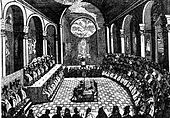This article may be too long to read and navigate comfortably. When this tag was added, its readable prose size was 18,000 words. (December 2023) |
| |
|---|---|

| |
| Date | 11 October 1962 – 8 December 1965 |
| Accepted by | Catholic Church |
Previous council | First Vatican Council (1869–1870) |
| Convoked by | Pope John XXIII |
| President |
|
| Attendance | Up to 2,625[1] |
| Topics | Complete unfinished task of Vatican I and ecumenical outreach to address needs of modern world |
Documents and statements | Four constitutions:
Nine decrees:
Three declarations:
|
| Chronological list of ecumenical councils | |
| Part of a series on the |
| Ecumenical councils of the Catholic Church |
|---|
 |
| 4th–5th centuries |
| 6th–9th centuries |
| 12th–14th centuries |
| 15th–16th centuries |
| 19th–20th centuries |
|
|
The Second Ecumenical Council of the Vatican, commonly known as the Second Vatican Council or Vatican II, was the 21st and most recent ecumenical council of the Catholic Church. The council met in Saint Peter's Basilica in Vatican City for four periods (or sessions), each lasting between 8 and 12 weeks, in the autumn of each of the four years 1962 to 1965, although it had been anticipated initially that the work of the Council would have been complete after three sessions.[2]
Pope John XXIII called the council because he felt the Church needed "updating" (in Italian: aggiornamento). In order to better connect with people in an increasingly secularized world, some of the Church's practices needed to be improved and presented in a more understandable and relevant way. Support for aggiornamento won out over resistance to change, and as a result the sixteen magisterial documents produced by the council proposed significant developments in doctrine and practice, notably
- Lumen gentium, the Dogmatic Constitution on the Church on "the universal call to holiness"
- Apostolicam actuositatem, a decree on The Apostolate of the Laity
- Orientalium Ecclesiarum, a decree On Eastern Catholic Churches
- Dei verbum, the Dogmatic Constitution on Divine Revelation emphasized the study of scripture as "the soul of theology"
- Sacrosanctum concilium, the Constitution on the Sacred Liturgy to restore "the full and active participation by all the people"
- Gaudium et spes, the Pastoral Constitution on the Church in the Modern World, concerned the promotion of peace, the gift of self, and the Church's mission to non-Catholics
- Dignitatis humanae, a declaration on religious freedom
- Unitatis redintegratio, a decree on Christian ecumenism
- Nostra aetate, a declaration about non-Christian religions
The council had a significant impact on the Church due to the scope and variety of issues it addressed.[3] Some of the most notable changes were in performance of the Mass, including that vernacular languages could be authorized as well as Latin.
- ^ Cheney, David M. "Second Vatican Council". Catholic Hierarchy. Retrieved 18 May 2011.
- ^ O'Riordan, S, The Third Session, The Furrow, Volume 15, No. 10 (October 1964), p. 621, accessed on 5 October 2024
- ^ O'Malley 2008.